See also
- Madredeus, a Portuguese musical ensemble
- Madre de Dios (disambiguation) same title in Spanish
Madre de Deus was a Portuguese treasure ship captured by English privateers in 1592.
Madre de Deus (Portuguese for Mother of God) may also refer to:

Água Grande is a district of São Tomé and Príncipe, on São Tomé Island. Its capital, São Tomé, is also the national capital of the equatorial Atlantic island nation of São Tomé and Príncipe. Covering only 16.5 km2 (6 sq mi), it is the smallest of the nation's seven districts in terms of area, but the largest in population with 69,454 residents in 2012 rising to an estimated 77,700 in 2018. It is divided into the two statistical subdistricts São Tomé and Pantufo.
Madre de Dios may refer to:

Vila Franca do Campo is a town and municipality in the southern part of the island of São Miguel in the Portuguese Autonomous Region of the Azores. The population of the municipality was 11,229 in 2011, in an area of 77.97 km². The town proper, which incorporates the urbanized parishes São Miguel and São Pedro, has 4100 inhabitants.

Azulejo ; from the Arabic al-zillīj, الزليج) is a form of Portuguese and Spanish painted tin-glazed ceramic tilework. Azulejos are found on the interior and exterior of churches, palaces, ordinary houses, schools, and nowadays, restaurants, bars and even railways or subway stations. They are an ornamental art form, but also had a specific functional capacity like temperature control in homes.

The Convent of Our Lady of Mount Carmel is a former Catholic convent located in the civil parish of Santa Maria Maior, municipality of Lisbon, Portugal. The medieval convent was ruined during the sequence of the 1755 Lisbon earthquake, and the destroyed Gothic Church of Our Lady of Mount Carmel on the southern facade of the convent is the main trace of the great earthquake still visible in the old city.

Jorge Afonso was a noted Portuguese Renaissance painter.

Cristóvão Lopes was a Portuguese painter.
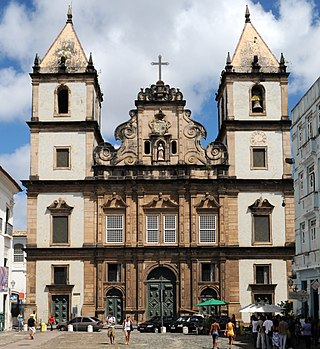
The São Francisco Church and Convent of Salvador is located in the historical centre of Salvador, in the State of Bahia, Brazil. The ornate Church of the Third Order of Saint Francis sits adjacent to the convent. The friars of the Franciscan Order arrived in Salvador in 1587 and constructed a convent and church on the site. This structure was destroyed by the Dutch during the Dutch invasions of Bahia in the next century; Father Vicente das Chagas initiated the current structure in 1686, which was completed in the 18th century. The Franciscan church and convent have the largest number of azulejos, 55,000, of any church in Latin America.
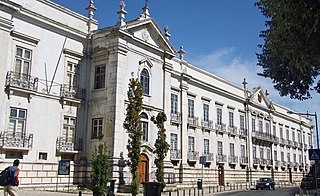
Penha de França is a freguesia and typical quarter of Lisbon, the capital of Portugal. Located in the historic center of Lisbon, Penha de França is north of São Vicente, east of Arroios, south of Areeiro, and west of Beato. The population in 2011 was 27,967,
Carmo may refer to:

Manor of Madre de Deus is a historic former residence of the Bettencourt family in the civil parish of Sé, in the municipality of Angra do Heroísmo, in the Portuguese archipelago of the Azores.
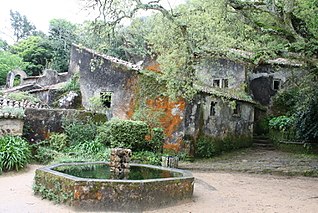
The Convent of the Friars Minor Capuchin, popularly known as the Convent of the Capuchos, but officially the Convento de Santa Cruz da Serra da Sintra, is a historical convent consisting of small quarters and public spaces located in the civil parish of São Pedro de Penaferrim, in Sintra Municipality, Portugal. Its creation was associated with the Portuguese Viceroy of India, D. João de Castro, and his family, but became a pious community of reclusive clergy that continued to occupy cramped humble spaces in the complex until the religious orders were abolished in Portugal.
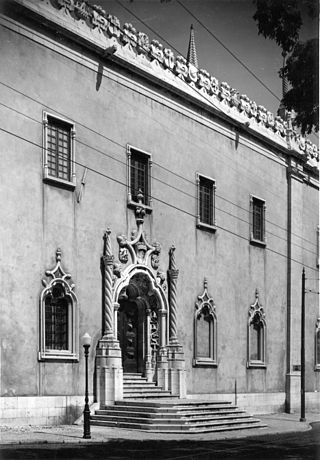
The Convento de Madre de Deus, or Madre de Deus Convent, is a former convent and church in Lisbon, Portugal, which houses the National Museum of the Azulejo. It is classified as a National Monument.

The Museu Nacional do Azulejo, occasionally known in English as the National Tile Museum, is an art museum in Lisbon, Portugal dedicated to the azulejo, traditional tilework of Portugal and the former Portuguese Empire, as well as of other Iberophone cultures. Housed in the former Madre de Deus Convent, the museum's collection is one of the largest of ceramics in the world.

The Convent of Caloura is a Portuguese 16th-century convent located in the civil parish of Água de Pau, in the municipality of Lagoa, on the island of São Miguel in the archipelago of the Azores.

The Hermitage of Mãe de Deus, is a hermitage situated on the hilltop of Ladeira da Mãe de Deus in the civil parish of São Pedro in the municipality of Ponta Delgada. The hermitage is notable for the intricately detailed cornerstones in black basalt coated in plaster, and painted in white. The stonework is primarily in the main facade and practically all of the area around the temple.

The Cult of the Lord Holy Christ of the Miracles, popularly known as Senhor Santo Cristo or Santo Cristo dos Milagres is a religious veneration associated with an image of Jesus Christ, depicted in the events of the New Testament. The wooden image of Christ, by unknown artist, in a Renaissance-style representation of the Ecce Homo, represents the episode of Jesus of Nazareth's life when the martyred religious figure was presented to the crowd following his whipping, and includes a crown of thorns, uncovered torso and bruised/beaten body. Narrated in the New Testament, the artist represented in grande artistic style the contrast between violence on the body and the serenity of the expression, emphasized by the gaze from the image.

The Convent of Santo António da Cidade is a former-convent and public library in the civil parish of Bonfim, in the municipality of Porto, in the Portuguese district of the same name.
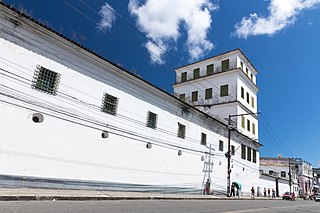
The Church and Convent of Our Lady of the Conception of Lapa (Portuguese: Igreja e Convento de Nossa Senhora da Conceição da Lapa is an 18th-century Roman Catholic church located in Salvador, Bahia, Brazil. The church is dedicated to Our Lady of the Conception and is part of the Roman Catholic Archdiocese of São Salvador da Bahia. It is known as key site in the Brazilian independence movement in the early 19th century. Sister Joana Angélica resisted the invasion of Portuguese troops into the convent and was killed by bayonet in 1822 at the south portal of the convent.

Os Dias da MadreDeus is the debut studio album by Portuguese group Madredeus. It was released in December 1987 by EMI-Valentim de Carvalho.